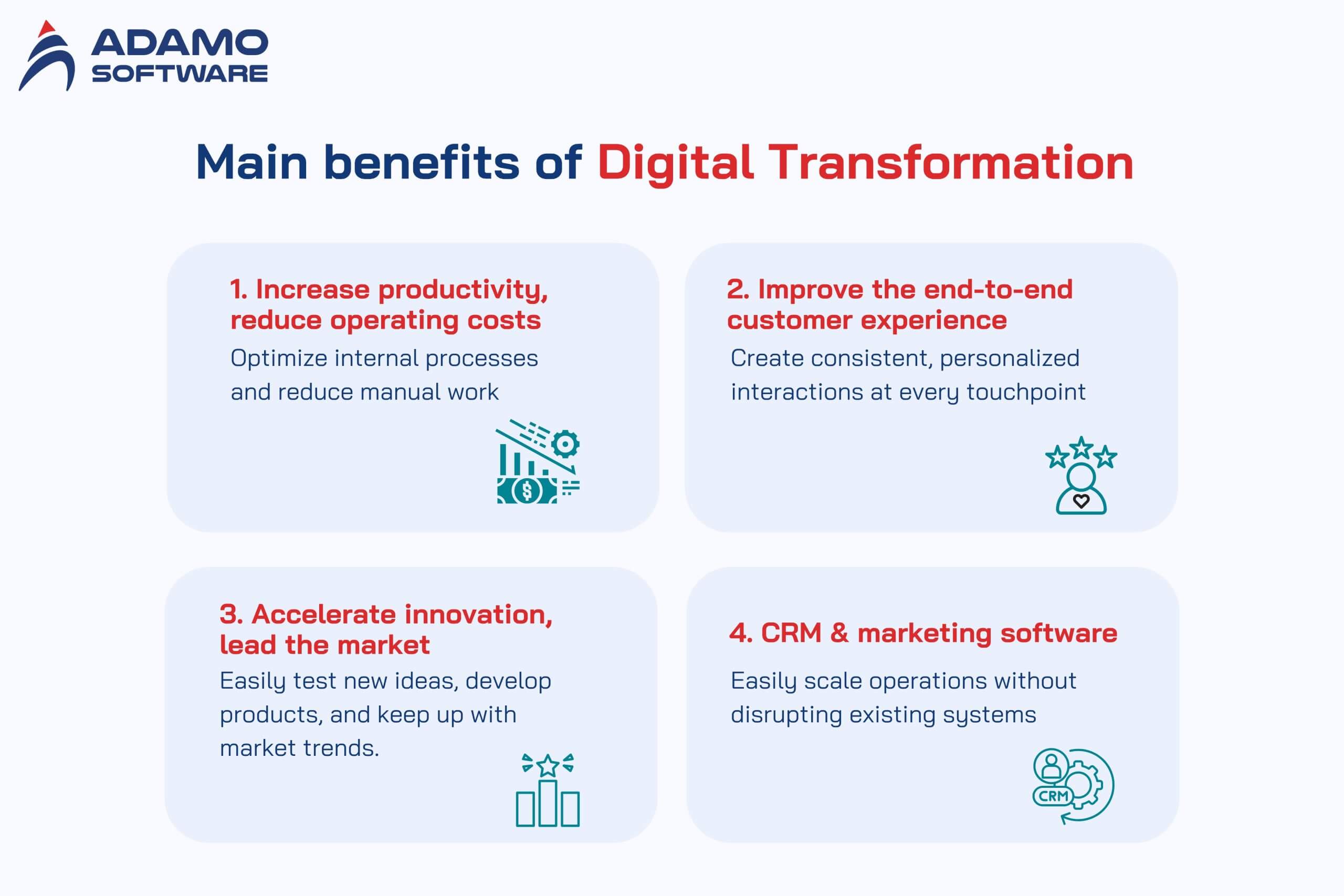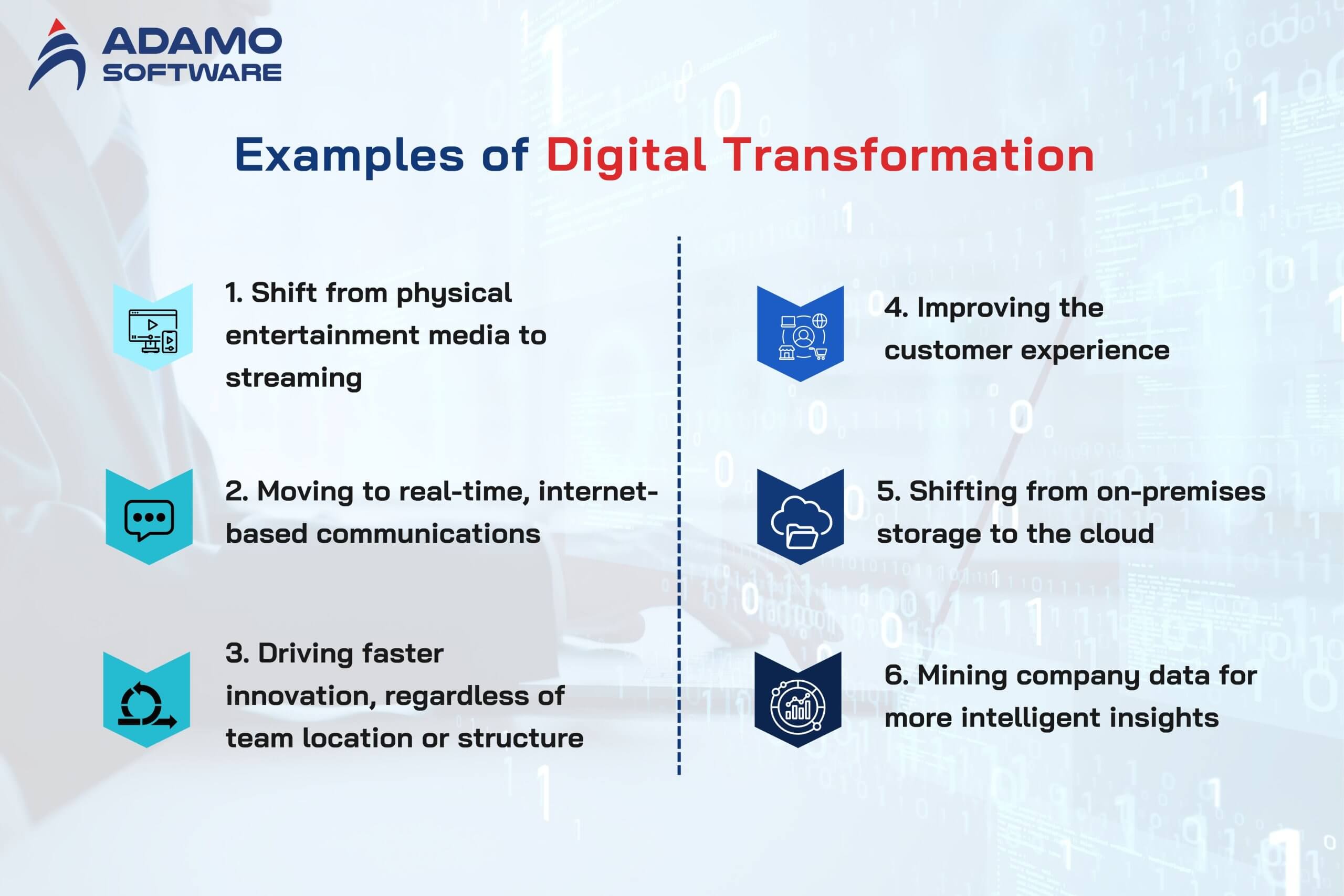What is digital transformation? Benefits, challenges and examples

Discover what is digital transformation, how it boosts business agility and innovation, plus real-world examples from leading global companies.
Digital transformation in business is applying technology to change the way of operation, create new value, and improve competitiveness. This is not just about digitizing documents or processes, but a comprehensive change in how businesses operate, make decisions, and serve customers.
In the context of a rapidly changing market, high customer expectations, and constantly evolving technology, digital transformation has become a vital factor. It enables businesses to:
- Speed up operations and reduce costs
- Improve customer experience
- Make data-driven decisions
- Rapidly scale with technology.
This article will help you understand:
- The concept of digital transformation in business
- Benefits of applying Digital Transformation
- Core technologies such as Cloud, AI, and Big Data
- Real-word examples of digital transformation
Whether you are an SME or a large corporation, it is time to “apply technology” and “think digitally” for sustainable development.
I. What is digital transformation and why it matters
Digital transformation is reshaping how businesses operate and grow. To truly understand why it matters, let’s explore what digital transformation actually means and how it’s reshaping today’s business landscape.
1. Definition of Digital Transformation
What is digital transformation? Digital transformation is the process of re-engineering a business by harnessing the full potential of modern technology. More than just speeding up old processes, digital transformation forces businesses to rethink how they operate. It means moving from manual methods to intelligent, data-driven, long-term adaptive systems. Instead of asking “How can we speed up old processes?”, digital transformation asks, “What can current technology help us do differently?”
A prime example of this process is Netflix. The company adopted streaming technology instead of optimizing the traditional video rental model. This allowed users to watch content anytime, anywhere. Netflix doesn’t stop there; it also uses AI (artificial intelligence) to personalize content recommendations for each user, turning a familiar service into a technology platform that leads the entertainment industry.
Therefore, the core of digital transformation is not speed, but a new approach—taking technology as the center for innovation, flexibility, and sustainable development.
Also read:
Digital Transformation Roadmap: Key types and actionable steps
Digital Transformation Examples: Top 10 real-world success
Explore Our Tailor-made Software Development Solutions
We are confident in providing end-to-end software development services from fully-functioned prototype to design, MVP development and deployment.
2. The significant impact of Digital Transformation
In today’s digitally driven landscape, digital transformation (DX) is no longer optional — it’s a matter of survival. Enterprises must rethink how they operate, create value, and serve customers, or risk falling behind.
Digital transformation (DX) is more than just adopting new technology. It is also about embedding digital technology into the core of the business. This helps improve customer experience, streamline operations, and unlock new revenue streams.
According to PwC’s 2024 Global CEO Survey, 97% of CEOs have taken action to redefine how they create and capture value. Of those, 76% have reshaped their business models. Alarmingly, 45% say their companies may not survive the next decade if they don’t transform faster.
But transformation can feel overwhelming. IBM’s CEO study found that 72% of leaders still view disruption as a risk rather than an opportunity. Combined with the decline in senior leadership trust in IT, it becomes clear that successful transformation requires a shift in leadership mindset, not just technical upgrades.
Modern CIOs must move beyond technology in leadership. They must become strategic enablers—connecting digital efforts to business objectives and driving sustainable organizational change.
II. Main benefits of Digital Transformation
Digital transformation isn’t only a tech upgrade; it’s a strategic shift in how value is delivered. It is how B2B businesses innovate, how they operate, adapt faster, and gain a competitive advantage in an ever-changing marketplace. When done right, digital transformation helps companies to operate more efficiently, save costs, and serve customers better.

Notable benefits include:
- Increased productivity – reduced costs: Optimize internal processes and reduce manual work to save resources.
- Enhanced customer experience: Create consistent, personalized interactions at every touchpoint to build loyalty and long-term value.
- Accelerated innovation: Easily test new ideas, develop products, and keep up with market trends.
- Flexible and scalable: Easily scale operations without disrupting existing systems.
1. Increase productivity, reduce operating costs
Digital transformation helps your business automate processes, standardize how you work, and eliminate the need for spreadsheets. It allows you to waste time on repetitive tasks any longer.
When operations run smoothly, your team will have more time to focus on critical, high-value tasks. This helps increase efficiency and significantly reduce personnel costs.
2. Improve the end-to-end customer experience
Today’s customers no longer interact through a single channel. They may start on a website, continue mobile, then switch to email or social media – all in one journey. Therefore, a well-connected digital business will capture all of these touchpoints. From there, respond quickly, personalize interactions, and make customers feel cared for.
3. Accelerate innovation, lead the market
In the B2B environment, rapid innovation is a competitive advantage. Digital transformation empowers businesses to experiment, gather real-time feedback, and adapt quickly to shifting market demands. Whether you are launching a new product or optimizing your service model, technological agility will help you stay ahead.
4. Flexibility to scale when needed
Cloud computing infrastructure and highly flexible systems make it easy for businesses to scale when opportunities arise. This includes deploying remote teams, handling sudden workload spikes, and entering new markets—all without the need for bulky infrastructure investments or worrying about disruptions.
III. Examples of Digital Transformation
Digital transformation is no longer optional — it’s essential for staying competitive in today’s fast-moving world. Here are real-world examples of how businesses are embracing digital to work smarter and grow faster:

Some standout examples include:
- Streaming platforms replace DVDs: Entertainment has gone digital, offering on-demand access anytime, anywhere.
- Cloud-based tools replace office emails: Teams now collaborate via Slack, Zoom, and shared docs in real time.
- Agile product development: Digital tools help launch new products faster, even with globally distributed teams.
- Omnichannel customer experience: Businesses meet customers anywhere — web, mobile, email, or social media.
- Cloud migration: Data is moved from physical servers to scalable, secure cloud environments.
- Data-driven decision-making: Advanced analytics turn raw data into strategic insights for better business choices.
1. Shifting from physical entertainment media to streaming
The entertainment industry is a classic example of a complete digital transformation. While in the past, users had to buy physical books, CDs, or DVDs to enjoy content, now everything is available at a touch. Netflix, Spotify, or Amazon Kindle have changed how users access content and redefined user expectations: instant access, sync across all devices, and personalized recommendations.
This shift has caused the collapse of “empires” such as Blockbuster or Borders. More importantly, the surviving companies have been forced to make comprehensive changes, from the supply chain and distribution to how content is licensed and interacted with customers. This demonstrates that digital transformation is not just about putting products online – it is about redesigning the entire operating model to adapt to the growing digital demand.
2. Moving to real-time, internet-based communications
Before the COVID-19 pandemic, many businesses still preferred face-to-face or email meetings. However, as the world shifted to remote work, platforms like Zoom, Microsoft Teams, and Slack became the “new meeting room” for every organization.
These tools are not just for video calling; they also integrate document sharing, task management, and connectivity with other internal systems. The result is shorter decision-making, faster feedback, and a much more flexible way of operating. For many companies, this is not just a temporary solution, but a foundation for building a more flexible and sustainable working model in the long term.
3. Driving faster innovation, regardless of team location or structure.
In the past, product development – especially between teams in many countries – was often slow and disconnected. With tools like Figma, Adobe XD, and product lifecycle management (PLM), software, design, engineering, and marketing teams can work together in real time on a single platform.
A prominent example is the fashion industry. During the pandemic, major brands quickly pivoted to designing loungewear based on consumer behavior analysis. Those who invested early in digital processes can organize remote fittings, test materials via AR, and launch products without facing order delays. This is a competitive advantage in today’s fast-changing market environment.
4. Improving the customer experience
Today, consumers are not only interested in products – they are also evaluating the journey they interact with brands. From quick responses, personalized recommendations, to the ability to synchronize experiences between websites, apps, and stores – everything must be “seamless”.
Businesses invest heavily in AI chatbots, mobile apps, omnichannel management systems, and user behavior analysis.
For example, an e-commerce platform can display personalized offers for each person based on their purchase history. At the same time, an airline allows customers to change seats or receive flight notifications on the app. These improvements not only bring satisfaction but also contribute to long-term customer retention.
5. Shifting from on-premises storage to the cloud
Healthcare used to be one of the most “conservative” industries in applying technology. However, with the development of cloud platforms and regulations on data digitization, hospitals and clinics have begun to switch from paper records to cloud-based EHR (electronic health records) systems.
This not only helps to receive patients faster, but also allows departments to share information easily, reducing errors in diagnosis and treatment. Patients can look up test results or book appointments on their phones – something that seemed impossible just a few years ago. For service providers, cloud platforms help scale, integrate telehealth, and ensure compliance with strict data privacy regulations.
6. Mining company data for more intelligent insights
One of the most significant achievements of digital transformation is the ability to turn raw data into actionable information. Businesses today no longer accept working in “data silos.” With platforms like Snowflake, Tableau, or Power BI, they can aggregate data from multiple sources and analyze it in real time.
Imagine a retail chain that knows precisely what items are selling in each branch, predicts how much stock they need for the next week, and automatically adjusts prices based on consumer trends – all on a single dashboard. What was once a “dream” is now a must to stay competitive in a fully digitalized market.
IV. Final thoughts
Digital transformation is no longer an option – businesses must adapt, compete, and grow sustainably. However, this journey is not simply investing in technology or deploying automation software. Companies need a comprehensive strategy, innovative thinking, and a technology partner that can understand business problems and the appropriate technology capabilities.

At Adamo Software, we have accompanied many businesses – from startups to large corporations – in the process of designing and implementing flexible digital transformation solutions, helping them:
- Upgrade technology infrastructure in a modern, scalable direction
- Optimize operational processes based on data.
- Improve customer experience through personalized digital platforms.
- And most importantly, build a sustainable competitive advantage in the digital market.
Are you seeking the right technology solution to accelerate digital transformation? Contact Adamo Software for a free consultation – from strategy building to custom software development for your business.











